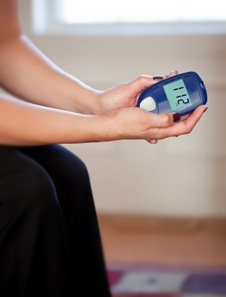Diabetes – Monitoring and Control in Canadian Health and Care Mall
The key to a successful life with diabetes is achieving good blood glucose control. Your degree of success can be judged only by measurements of your body’s response to treatment. If you have diabetes, the fact that you feel well does not necessarily mean that your blood glucose is well controlled. It is only when control goes badly wrong that you may be aware that something is amiss. If your blood glucose is too low, you may be aware of hypo symptoms -if left untreated this may progress to unconsciousness (hypoglycaemic coma). At the other end of the spectrum, when the blood glucose concentration rises very steeply, you may be aware of increased thirst and passing urine excessively – left untreated, this may progress to nausea, vomiting, weakness, and eventual clouding of consciousness and coma (a condition called ketoacidosis). It has long been apparent that relying on how you feel is too imprecise, even though some people may be able to ‘feel’ subtle changes in their control. 
For this reason, many different tests have been developed to allow precise measurement of control and, as the years go by, these tests become more efficient and accurate.
Twitter Canadian health care mall – https://twitter.com/healthcare_mall.
The involvement of the person with diabetes in monitoring and control of their own condition has always been essential for successful treatment. With the development of blood glucose monitoring, this has become even more apparent: it allows you to measure precisely how effective you are at balancing the conflicting forces of diet, exercise and insulin, and to make adjustments in order to maintain this balance with. In the early days after the discovery of insulin, urine tests were the only tests available and it required a small laboratory even to do these. Urine tests have always had the disadvantage that they are only an indirect indicator of what you really need to know, which is the level of glucose in the blood. Blood glucose monitoring first became available to people with diabetes in 1977 and is now widely accepted. As anyone who has monitored glucose levels in the blood will know, these vary considerably throughout the day as well as from day to day. For this reason, a single reading at a twice yearly visit to the local diabetes clinic is of limited value in assessing long-term success or failure with control.
The introduction of haemoglobin Ale (glycosylated haemoglobin or HbA1c) has provided a very reliable test for longer-term monitoring of average blood glucose levels (taking into account the peaks and troughs) over an interval of two to three months. Someone with diabetes should aim at a target HbA1c of 7%, which indicates that the blood glucose has been contained within the near normal range. Provided there have been no troublesome hypoglycaemic attacks, this means that balance of diabetes has been excellent and no further changes are required. Achieving a normal HbA1c level and maintaining it as near normal as possible is an important goal. Not everyone can achieve this, but it is undoubtedly the most effective way of eliminating the risk of long-term complications.